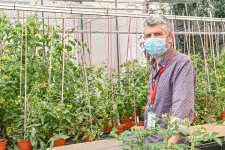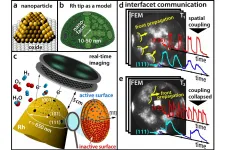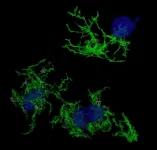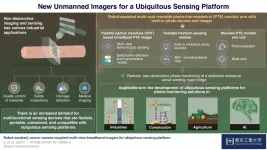New mechanism to control tomato ripening discovered
It opens the door to producing tomatoes of a higher commercial and nutritional quality
2021-05-21
(Press-News.org) An international research group involving the Institute of Molecular and Cellular Biology of Plants (IBMCP), a joint centre of the Universitat Politècnica de València (UPV) and the Spanish National Research Council (CSIC), has discovered that a genetic mechanism, called CHLORAD, which is involved in the ageing of plant leaves, also plays a decisive role in the tomato ripening process. Thus, tomatoes with an activated CHLORAD system turn red more quickly, and accumulate more lycopene, a compound beneficial to health. The results, which have been published in the latest issue of the journal Nature Plants, will lead to better quality tomatoes.
The ripening of most fleshy fruits gives them attractive colours and smells, which is a trick of the plant to spread its seeds more widely and colonise new territories. In tomatoes, ripening changes their colour from green to orange and red. The green is due to the presence of chlorophyll (the photosynthesis pigment) in the chloroplasts of the immature fruits. When they ripen, the chloroplasts (the organs in charge of photosynthesis) lose that chlorophyll and produce large quantities of other pigments, called carotenoids.
Tomato carotenoids are orange (due to beta-carotene) and red (due to lycopene), which causes the fruit to change colour when ripe. In addition, these carotenoids form aromas that contribute to the characteristic smell of ripe tomatoes. For all this to happen, the chloroplasts need to be transformed into a new type of carotenoid storage compartment, called a chromoplast.
Until recently, it was not known how the tomato plant controls the transformation of chloroplasts into chromoplasts. Now, a research group from the University of Oxford (UK) in collaboration with the Valencian Institute of Molecular and Cell Biology of Plants (IBMCP) has unravelled part of this mystery, in an article published in the journal Nature Plants.
The key to this work comes from Arabidopsis, a plant used as a study model that does not develop chromoplasts naturally, but does transform its chloroplasts during a process -known as leaf senescence- in which the leaves age, lose their chlorophyll and stop photosynthesising. During this process, a molecular mechanism called CHLORAD removes complexes in the outer layer of chloroplasts that import proteins needed for photosynthesis.
Tomatoes that turn red sooner
Researchers have found that the CHLORAD system also works during tomato ripening. When activated, it prevents the import of photosynthetic proteins, but promotes the incorporation of other proteins necessary for the production and storage of carotenoids during the transformation of chloroplasts into chromoplasts. Thus, fruits with an activated CHLORAD system turn red sooner and accumulate more of the health-promoting carotenoid lycopene, while fruits with a deficient CHLORAD system take longer to ripen.
"In addition to better understanding how chloroplasts are transformed into chromoplasts, we now know that this process not only regulates fruit pigmentation, but also affects many other aspects linked to ripening that influence the firmness or the aroma of tomatoes," says Manuel Rodríguez Concepción, a CSIC researcher at the IBMCP who is participating in this study. The challenge now is to understand the connections between these mechanisms in order to produce tomatoes of a higher commercial and nutritional quality without sacrificing their characteristic colour, aroma and flavour.
INFORMATION:
[Attachments] See images for this press release:

ELSE PRESS RELEASES FROM THIS DATE:
2021-05-21
Most of commercial chemicals are produced using catalysts. Usually, these catalysts consist of tiny metal nanoparticles that are placed on an oxidic support. Similar to a cut diamond, whose surface consists of different facets oriented in different directions, a catalytic nanoparticle also possesses crystallographically different facets - and these facets can have different chemical properties.
Until now, these differences have often remained unconsidered in catalysis research because it is very difficult to simultaneously obtain information about the chemical reaction itself and about the surface structure of the catalyst. At TU Wien (Vienna), this has now been achieved by combining different microscopic methods: with ...
2021-05-21
SINGAPORE, 21 May 2021 - Alzheimer's Disease is the most common form of dementia and is characterised by the build-up of amyloid plaques in the brain. Microglia, the immune sentinels of the brain, are not only responsible for eliminating foreign invaders, but also maintaining brain homeostasis by clearing toxic waste such as the amyloid plaques.
However, the role of microglia in Alzheimer's Disease and its relationship to amyloid plaque accumulation remain unclear. Now, a team of scientists from Duke-NUS Medical School and Monash University have found the gene expression signatures underlying microglia associated ...
2021-05-21
More than 100 kg of highly toxic uranium (U) and plutonium (Pu) was dispersed in the form of tiny 'hot' radioactive particles after the British detonated nine atomic bombs in remote areas of South Australia, including Maralinga.
Scientists say that these radioactive particles persist in soils to this day, more than 60 years after the detonations. Previously, we had limited understanding of how Pu was released from these "hot" particles into the environment for uptake by wildlife around Maralinga.
But now, a new study published today in Scientific Reports and led by Monash University researchers warns that the particles are actually more ...
2021-05-21
A new study shows that the current rate of biodiversity decline in freshwater ecosystems outcompetes that at the end-Cretaceous extinction that killed the dinosaurs: damage now being done in decades to centuries may take millions of years to undo.
The current biodiversity crisis, often called the 6th mass extinction, is one of the critical challenges we face in the 21st century. Numerous species are threatened with extinction, mostly as a direct or indirect consequence of human impact. Habitat destruction, climate change, overexploitation, pollution and invasive species are among the main causes for Earth's biota to decline rapidly.
To investigate the tempo of extinction and predict recovery times, an international team of evolutionary biologists, paleontologists, geologists and modelers ...
2021-05-21
One of the key aspects of academic and industrial research today is non-destructive imaging, a technique in which an object or sample is imaged (using light) without causing any damage to it. Often, such imaging techniques are crucial to ensuring safety and quality of industrial products, subsequently leading to growing demands for high-performance imaging of objects with arbitrary structures and locations.
On one hand, there has been tremendous advancements in the scope of non-destructive imaging regarding the region of electromagnetic (EM) spectrum it can access, which now ranges from visible light to as far as millimeter waves! On the other, imaging devices have become flexible and wearable, enabling stereoscopic (3D) visualization ...
2021-05-21
Because individual atoms or molecules are 100 to 1000 times smaller than the wavelength of visible light, it is notoriously difficult to collect information about their dynamics, especially when they are embedded within larger structures.
In an effort to circumvent this limitation, researchers are engineering metallic nano-antennas that concentrate light into a tiny volume to dramatically enhance any signal coming from the same nanoscale region. Nano-antennas are the backbone of nanoplasmonics, a field that is profoundly impacting biosensing, photochemistry, solar energy harvesting, and photonics.
Now, researchers at EPFL led by Professor Christophe Galland at the School of Basic Sciences ...
2021-05-21
Research has shown that joining a gang is associated with increased criminal behavior. A new study examined whether the intermittent nature of gang membership affects offending. Researchers sought to determine whether the association with increased offending was a consistent attribute or, since people enter and exit and re-enter gangs, whether the intermittent nature of membership affected members' likelihood of offending. The study found that first-time membership was associated with increases in criminal behavior from when gang members were not in gangs, and that joining for a second ...
2021-05-21
The plant Aristolochia microstoma uses a unique trick: its flowers emit a fetid-musty scent that seems to mimic the smell of decomposing insects. Flies from the genus Megaselia (family Phoridae) likely get attracted to this smell while searching for insect corpses to mate over and lay their eggs in. When they enter a flower, they are imprisoned and first pollinate the female organs, before being covered with pollen by the male organs. The flower then releases them unharmed.
"Here we show that the flowers of A. microstoma emit an unusual mix of volatiles that includes alkylpyrazines, which are otherwise rarely produced by flowering plants. Our results suggest that this is the first known case of a flower that tricks pollinators by smelling like dead and rotting insects rather than vertebrate ...
2021-05-21
UK doctors have nothing to fear from the introduction of a central register listing money or benefits they receive in addition to their NHS salary, say experts today ahead of a public meeting on the issue hosted by the All-Party Parliamentary Group for First Do No Harm and The BMJ.
Last year the Independent Medicines and Medical Devices Safety Review, chaired by Baroness Julia Cumberlege, investigated harmful side effects caused by the hormone pregnancy test Primodos, the anti-epileptic drug sodium valproate, and pelvic mesh.
During the review, she heard from patients who were concerned that clinicians ...
2021-05-21
Within the next decade, the novel coronavirus responsible for COVID-19 could become little more than a nuisance, causing no more than common cold-like coughs and sniffles. That possible future is predicted by mathematical models that incorporate lessons learned from the current pandemic on how our body's immunity changes over time. Scientists at the University of Utah carried out the research, now published in the journal Viruses.
"This shows a possible future that has not yet been fully addressed," says Fred Adler, PhD, professor of mathematics and ...
LAST 30 PRESS RELEASES:
[Press-News.org] New mechanism to control tomato ripening discovered
It opens the door to producing tomatoes of a higher commercial and nutritional quality






